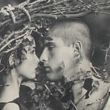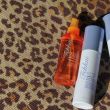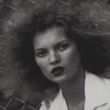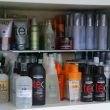“I grew up in Paris. I don’t know exactly what interested me in hair. I have no idea. I was never interested in my own hair, more than anybody else my age. My father had a friend who was a barber—a hairdresser for men. But I don’t know that he had any influence on me. The good thing was that my mother worked in a veterinary clinic and one of her customers was one of the Carita sisters. They were two sisters, Maria and Rosie, and Rosie had animals. I guess they were little poodles. And when I chose to become a hairdresser, my mother said, ‘Oh I’m going to talk to Rosie Carita and see if you can do your apprenticeship there.’ And that’s pretty much the way I became involved in fashion.
I only started reading fashion magazines when I was at Carita. I started there in the mid-sixties and I was still living with my parents. At that time it was really one of the top beauty salons; I think maybe 125 people were working there. The women who could afford it, would come back every two days, three days, to get a ‘do’. It was a set, with teasing and hairspray—[L’Oreal] Elnett was huge then. I think in France they were a little bit backwards when it came to trends; the leading country was definitely England—everybody wanted to be a hairdresser or a manager, or a musician. But in France it was still kind of classical. At that time for photoshoots, it was a different system. You used to go to the studio, you did the hair, and you left! They were using a lot of hairspray, doing up-dos, nothing was really moving, so there was nothing more to do once you set the hair. And at the time also the models were more agile with the hair—they could correct it themselves. It was not as precise as it is now; it was a less controlled environment.
Then after that I went to another really big salon called Jean Louis David. He also came from Carita. I never really had any customers; I was assisting other hairdressers. I think when you start something new you just want to copy, to learn. It’s only after that you start to have your own ideas. Around that time there began to be a demand for hairdressers for magazine work, and that’s where I started. I’ve always worked mainly on photoshoots. I think first of all it’s easier to do hair on someone who is 18 or 20 years old and beautiful, than doing it on someone who is 50 years old and not so fresh anymore! [Laughs] And in a salon there is always the politics—a client moves from one hairdresser to another and it becomes very tense. I’m not so interested in those politics. At that time there were very few people working in what I was doing—there was a group from Mod’s Hair. It was not fighting each other like it is now! So very quickly I began to work with Helmut Newton, Bob Richardson, and from time to time Guy Bourdin. I mean really very good people. I always liked to work with Bob Richardson. First of all I didn’t speak very much English, so it was more about watching and listening and seeing what you could get from a conversation. There was not so much verbal communication. It was more about naming a movie, as a reference. He was an artist, and all the models were attracted to him and to his pictures. He was always extremely nice to me. If you had only lived in France like I had, his world was so strange—kind of like hippies with credit cards. It was a very mysterious world. Now I see Terry as an adult, and at the time I knew him as three or four years old. His upbringing was totally liberal compared to a French kid of his age. They had a Fiat 500 which is a tiny little car, and he always had to share it with a huge poodle, like a royal poodle. And he always had to sit in the back with the poodle. Then I started to come to America in the early seventies, maybe 1973. In the beginning I was working mostly for Mademoiselle and Glamour. Definitely the most fun magazine was Mademoiselle. They had really fun editors, for example Deborah Turbeville. Everyone had a personality—that Annie Hall look, that came from Mademoiselle. The editors were all dressed like this. Kind of bohemian. Before you could work for Vogue, as a photographer, you had to work for Mademoiselle and graduate. Obviously it’s not like this anymore. At the time at Vogue it was Polly Mellen, and I was never totally part of her team. Another person who I’ve really enjoyed working with is Bruce Weber, and also Patrick Demarchelier.
In general I think photographers are very opinionated about what a woman should look like. Some give you a little bit more freedom than others, but they definitely see the woman one way. Helmut definitely liked a certain style of woman. It was always the same type of woman. She may have shorter hair or she may have longer hair but it was always the woman who goes to the hairdresser every day, who doesn’t really have an occupation except, how do you call it, maybe taking care of certain men. [Laughs] Or being taken care of. You had to be technically very good to do this kind of hairstyle. And if you look at his books there are some really good hairstyles—one book called Pages from the Glossies, they took all the editorial he did and put it all into one book. There’s some really good stuff there. Steven Klein, he has his idea of a woman, and Inez [van Lamsweerde] has an idea of a woman who is maybe a little bit like her. But the photographer definitely has to be your best friend on that day. It’s good to know a little bit about the shoot beforehand, who will be there, what’s the direction. It’s always nice to know what will be the feeling, and if you’re going to work outside or inside. And once you’re there it’s good to compare ideas, but some people kind of talk and talk and talk and it doesn’t go far. Some photographers show you a picture and say ‘this is what I want’ but then again your interpretation can be slightly different. In the end, there is always your personality that shows through in the work. There’s an area of freedom.
I like to do shows; I’d like to do more. It really represents the work of the hairstylist. And because those pictures are used by magazines as the reference for the season, it really puts you in a different section. I did several really good seasons with Proenza. That was fun, to work with them. But it’s not easy to make 35 or 40 people look good. Sometimes they arrive fifteen minutes before the show and you have to make sure your team has high energy and will be there when you need them. You know for the shows, you have to find a team of people to do the hair with you. I mean people like Luigi [Murenu] and Guido have like 40 people on hold in Paris to work with them. But the thing I kind of admire is how well the hair is done. The gel trend this season was nothing new for me, because for many years I was working with Helmut Lang and that’s pretty much what we did for Helmut Lang: always a part on the side, or part in the middle, and a ponytail. Trends are always reinterpreted. I mean like the Prada hair, it could be something that we did in the 70’s, but he [Guido] has an amazing team and it’s always so well done. Like instead of having one little chignon, having two pigtails.
It’s difficult for me to say if I have a ‘signature style’; I think you have to ask another person! But I think it’s something that is not rigid, something that is approachable. For pictures, sometimes I like to do things that are kind of eccentric. But for me, it’s difficult to see hair as something that you can’t touch. Hair should be more free, not really solid. I touch the hair a lot. You know, it’s like a stylist—some people touch the dress, some people send their assistants to touch it and some people don’t touch it at all and let it go. I always like to have some kind of a ‘touch’. Quite a while ago Frederic Fekkai called me and said I would like to work with you and I would like you to teach some of my people what you know. And at that time I was also taking some pictures, so I did some pictures for Frederic for a while. I’ve been using his products for many years, and he has so many different ones. I like the Marine Beach Waves spray a lot—it makes your hair a little bit crumply. There’s also the Silky Straight Ironless Smooth Finish Serum, that makes your hair very kind of shiny. Both give the hair a kind of texture I like. But I think now there’s much more exploration in color than there is in haircuts. Most women have long hair. I like doing short hair; I mean for us [hairstylists] it’s fun to cut hair!”
—as told to ITG














